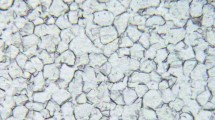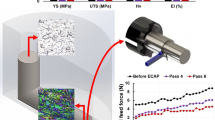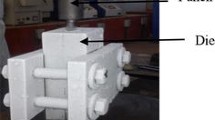Abstract
The processing routes in equal channel angular pressing (ECAP), which are defined by rotating the billet around its longitudinal axis between two consecutive passes, have an essential effect on the amount of grain refinement. However, in most of the previous studies, first, dies with a channel angle of 90° have been mostly used. second, the effect of ECAP routes has been only investigated on the resultant grain size, and the dislocation density has rarely been addressed. In order to cover the mentioned research gap, in this research, firstly, a different channel angle was chosen from other previous studies. Secondly, besides the grain size, the emphasis was placed on the calculation of the dislocation density, which has not been addressed in previous studies. To achieve this goal, the capability of different ECAP routes (A, BA, BC, B45, and C) on the amount of grain refinement and dislocation density induced in commercial purity titanium (CP-Ti) in a 105° ECAP die was investigated. ECAP was conducted at 250 °C for eight passes. Besides direct observations by transmission electron microscopy (TEM), the microstructure was also characterized by analyzing the broadening of the X-ray peak profiles using the modified Warren–Averbach method. The main findings were as follows: (1) In terms of grain size refining capability, both TEM and X-ray analysis demonstrated that BC is the most efficient route while C is the least efficient one. The order of efficiency was as: BC > BA > B45 > A > C. (2) Different result has been obtained for dislocation density. Route A was seen to make the highest amount of dislocation density in titanium after eight ECAP passes (\({\rho }_{A}=1.09 \times {10}^{16}{\mathrm{m}}^{-2})\). This value is nearly twice that measured for route C. (3) The ability of different ECAP routes to increase the dislocation density of titanium was obtained as A > BA > BC > B45 > C. The above results indicate that using an ECAP die with a larger channel angle may give different results than those generally obtain from 90° dies. At least in the case of commercially pure titanium, it was observed that to reach the highest dislocation density, route A is much more effective than route BC which is often known as the best route in ECAP.







Similar content being viewed by others
Data availability
All data generated or analysed during this study are included in this published article.
References
Y. Chehrehsaz, K. Hajizadeh, A. Hadjizadeh, L. Moradi, S. Mahshid, Met. Mater. Int. (2022). https://doi.org/10.1007/s12540-021-01003-9
G. Lutjering, J.C. Williams, Titanium, 2nd edn. (Springer, Berlin, 2003), pp.3–12
Z. Zhang, Q. Yang, Z. Yu, H. Wang, T. Zhang, Mater. Charact. (2022). https://doi.org/10.1016/j.matchar.2022.111962
J. Xie, Y. Chen, L. Yin, T. Zhang, S. Wang, L. Wang, J. Manuf. Process (2021). https://doi.org/10.1016/j.jmapro.2021.02.009
K. Hajizadeh, B. Eghbali, K. Topolski, K.J. Kurzydlowski, Mater. Chem. Phys. (2014). https://doi.org/10.1016/j.matchemphys.2013.11.001
M. Eftekhari, G. Faraji, S. Nikbakht, R. Rashed, R. Sharifzadeh, R. Hildyard, M. Mohammadpoor, Mater. Sci. Eng. A. (2017). https://doi.org/10.1016/j.msea.2017.07.088
G.G. Yapici, I. Karaman, H.J. Maier, Mater. Sci. Eng. A (2006). https://doi.org/10.1016/j.msea.2006.06.082
V.V. Stolyarov, Y.T. Zhu, I.V. Alexandrov, Mater. Sci. Eng. A (2001). https://doi.org/10.1016/S0921-5093(00)01411-8
M.J. Qarni, G. Sivaswamy, A. Rosochowski, S. Boczkal, Mater. Des. (2017). https://doi.org/10.1016/j.matdes.2017.03.015
S. Kadiyan, B.S. Dehiya, Mater. Res. Express (2019). https://doi.org/10.1088/2053-1591/ab4a44
V.V. Stolyarov, Y.T. Zhu, I.V. Alexandrov, T.C. Lowe, R.Z. Valiev, Mater. Sci. Eng. A (2001). https://doi.org/10.1016/S0921-5093(00)01411-8
R.Z. Valiev, R.K. Islamgaliev, I.V. Alexandrov, Prog. Mater. Sci. (2000). https://doi.org/10.1016/S0079-6425(99)00007-9
R.Z. Valiev, T.G. Langdon, Prog. Mater. Sci. (2006). https://doi.org/10.1016/j.pmatsci.2006.02.003
K. Nakashima, Z. Horita, M. Nemoto, T.G. Langdon, Mater. Sci. Eng. A (2000). https://doi.org/10.1016/S0921-5093(99)00744-3
S.L. Semiatin, V.M. Segal, R.E. Goforth, Metall. Mater. Trans. A (1999). https://doi.org/10.1007/s11661-999-0290-7
K. Hajizadeh, B. Eghbali, Met. Mater. Int. (2014). https://doi.org/10.1007/s12540-014-2014-9
P.R. Celtin, M.T. Paulino Aguilar, R.B. Figueiredo, T.G. Langdon, J. Mater. Sci. (2010). https://doi.org/10.1007/s10853-010-4384-9
R.B. Figueiredo, P.R. Celtin, T.G. Langdon, Acta Mater. (2007). https://doi.org/10.1016/j.actamat.2007.04.043
R.B. Figueiredo, M.T. Paulino Aguilar, P.R. Celtin, Mater. Sci. Eng. A (2006). https://doi.org/10.1016/j.msea.2006.05.116
P.B. Prangnell, A. Gholinia, V.M. Markushev, in investigations and applications of severe plastic deformation. ed. by T.C. Lowe, R.Z. Valiev (Kluwer Academic Pub, Dordrecht, 2000), pp.65–71
M.R. Movaghar Garabagh, S. Hossein Nedjad, H. Shirazi, M. Iranpour Mobarekeh, M. Nili Ahmadabadi, Thin Solid Films (2008). https://doi.org/10.1016/j.tsf.2008.04.019
K. Hajizadeh, V. Abbasi Chianeh, K.J. Kurzydlowski, Appl. Phys. A (2022). https://doi.org/10.1007/s00339-022-05885-3
L. Liang, M. Xu, Y. Chen, T. Zhang, W. Tong, H. Liu, H. Wang, H. Li, Mater. Sci. Eng. A (2021). https://doi.org/10.1016/j.msea.2021.141507
G.K. Williamson, W.H. Hall, Acta. metal. (1953). https://doi.org/10.1016/0001-6160(53)90006-6
T. Ungar, J. Gubicza, G. Ribarik, A. Borbely, J. Appl, Cryst. (2001). https://doi.org/10.1107/S0021889801003715
C. Zhang, H. Khorshidi, E. Najafi, M. Ghasemi, J. Clean. Prod. (2023). https://doi.org/10.1016/j.jclepro.2022.135390
B.E. Warren, B.L. Averbach, J. Appl. Phys. (1950). https://doi.org/10.1063/1.1699713
B.E. Warren, X-ray diffraction (Dover Pub, New York, 1990), pp.81–89
B.E. Warren, Prog. Met. Phys. (1959). https://doi.org/10.1016/0502-8205(59)90015-2
M. Wilkens, Phys. Status. Solidi. A (1970). https://doi.org/10.1002/pssa.19700020224
T. Ungar, A. Borbely, Appl. Phys. Lett. (1996). https://doi.org/10.1063/1.117951
I.C. Dragomir, T. Ungar, J. Appl. Cryst. (2002). https://doi.org/10.1107/S0021889802009536
Y.T. Zhu, T.C. Lowe, Mater. Sci. Eng. A (2000). https://doi.org/10.1016/S0921-5093(00)00978-3
E. Guler, G. Ugur, S. Ugur, M. Guler, R. Khenata, Bull. Mater. Sci. (2021). https://doi.org/10.1007/s12034-020-02342-w
Acknowledgements
The authors thank Urmia University of Technology for their technical support, which made this research possible.
Author information
Authors and Affiliations
Contributions
All authors contributed to the study’s conception and design. Material preparation, data collection, and analysis were performed by [KH], [HF] and [KJK]. The first draft of the manuscript was written by [KH], and all authors commented on previous versions of the manuscript. All authors read and approved the final manuscript.
Corresponding author
Ethics declarations
Conflict of interest
The authors have no conflicts of interest to declare.
Additional information
Publisher's Note
Springer Nature remains neutral with regard to jurisdictional claims in published maps and institutional affiliations.
Rights and permissions
Springer Nature or its licensor (e.g. a society or other partner) holds exclusive rights to this article under a publishing agreement with the author(s) or other rightsholder(s); author self-archiving of the accepted manuscript version of this article is solely governed by the terms of such publishing agreement and applicable law.
About this article
Cite this article
Hajizadeh, K., Farhad, H. & Kurzydlowski, K.J. Effect of ECAP processing routes on the microstructural characteristics of commercial purity titanium. Appl. Phys. A 129, 583 (2023). https://doi.org/10.1007/s00339-023-06868-8
Received:
Accepted:
Published:
DOI: https://doi.org/10.1007/s00339-023-06868-8




